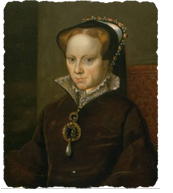

Mary Tudor was born on the 18 February 1516 at Greenwich Palace. Her father was King Henry VIII. Her mother was Catherine of Aragon, a devout Roman Catholic. Mary would be their only child to survive and reach adulthood.
Mary was baptised in a Catholic ceremony at the Church of the Observant Friars in Greenwich. Several high ranking members of the nobility witnessed the event. Cardinal Wolsey stood as her godfather. Mary’s godmothers included Katherine Courtenay, Countess of Devon who was the daughter of Edward IV. Another godmother was Margaret Pole, Countess of Salisbury who was the daughter of George, Duke of Clarence (brother to Edward IV and Richard III).
Henry and Catherine took a keen interest in their daughter’s upbringing. Henry was very fond of her. No expense was spared in her household. One of her first governesses was Lady Margaret Bryan who was subsequently replaced by the Countess of Salisbury. The Countess would become a valued friend and supporter of both Mary and her mother. Catherine ensured Mary had a good education.
The Spaniard Juan Luis Vives was employed as one of her tutors. Vives advocated the education of women although he still emphasised the virtues of chastity and humility and the need to be a dutiful wife. Vives wrote On a Plan of Study for Children which outlined a course of study for Mary. Mary read from the Scriptures and also studied texts such as Utopia by Thomas More, the Dialogues of Plato and the Education of a Christian Prince by Erasmus. She also received lessons in Latin and French. Mary had a talent for playing the lute and the virginals. Mary also enjoyed dancing, hunting, riding and hawking. One of her most favourite pastimes would be gambling, often running up large debts.
In 1525, at the age of nine, Mary was sent to live at Ludlow Castle with her own Court. The heir to the throne was usually given the title of the Prince of Wales. Although never officially invested with the title ‘Princess of Wales’, Mary was sent to preside over the Council of Wales in the Marches and represent royal authority. Mary remained there for about 18 months. In 1527 Henry VIII announced his intention to have the Pope annul his marriage to Catherine of Aragon. Mary chose to support her mother. The relationship with her father deteriorated. In 1531 Henry banished Catherine from Court. Henry forbade Mary from seeing her mother. During this period Mary was frequently unwell, suffering with stomach pains and headaches.
The Terrible Tudors: Misery Mary (The Horrible Histories Collection)
 |
 |
 |
